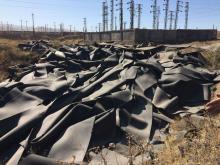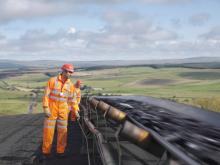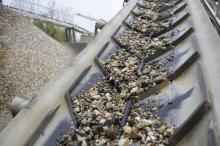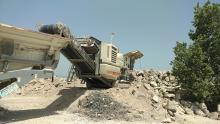Millions of euros are being wasted by the aggregates industry every year because the conveyor belts they are using are wearing out much faster than they should be doing. The biggest single cause is that the rubber is of insufficient quality and provides inadequate resistance to the abrasive actions of the materials it is carrying. But there is more to it than that.
Conveyor belt specialist Leslie David looks at the question of abrasion-resistant belting and provides some helpful advice on how to reduce costs by selecting belts that provide a much longer and cost-effective working lifetime.
It’s all about the quality
The wear-resistant quality of the outer covers of a conveyor belt is the biggest single influence on the working life of the belt and consequently its ‘whole life’ economic cost. The rubber used for the outer covers usually constitutes at least 70% of the overall thickness of both multi-ply and steel cord belts. This makes the cost rubber the single biggest element of cost when manufacturing a conveyor belt.
Consequently, it is, therefore, the single most significant opportunity for manufacturers to minimize costs and to compete for orders based on price rather than quality and performance. From the buyer’s point of view, although the price of a belt may be 30% lower than other offers, if it wears out 50% faster than the apparently higher-priced version, then it really is not such a bargain after all.
The wear-resistant quality conveyor belt
The wear-resistant quality of the covers is the biggest influence on the ‘whole life’ cost of a conveyor belt
Two of the most common methods used to minimize rubber costs are using recycled rubber, usually of highly questionable origin, within the mix and the use of cheap ‘bulking’ fillers such as chalk to replace part of the rubber polymers in the rubber compound.
There are a great many different types of rubber compound used because modern-day belts have to deal with a multitude of different (and often combined) demands. Because of its adaptability, most of the rubber used in conveyor belting is synthetic. Hundreds of different chemical components and substances are needed to create these synthetic rubber compounds that, once vulcanized, are able to meet the specific physical performance and safety requirements.
Yet another corner-cutting method employed by manufacturers of ‘economy’ belting is the use of a low grade, cheap form of carbon black created by burning used car tires. Some 20% of the rubber compound is made up of carbon black, so it has a notable impact on cost.
Good quality carbon black is created by a process of burning oil in a highly controlled, low oxygen environment so that combustion is incomplete. Burning used car tires not only pollutes the atmosphere it also means that the carbon black it creates contains the potentially harmful chemicals previously contained in the tires that will go on to form part of the conveyor belt.
Different kinds of wear and tear
It is a common misconception that a belt specified by a supplier as being ‘abrasion resistant’ should naturally be expected not to wear quickly. Different causes of wear and abrasion require different kinds of abrasion resistant covers.
For example, belts that transport heavy and/or sharp objects such as rocks, timber or glass that cause cutting and gouging of the belt surface need different resistance properties compared to belts carrying ‘fine’ materials such as aggregate, sand and gravel, which literally act like a piece of coarse sandpaper that is constantly scouring the rubber cover.
‘Fine’ act like a piece of coarse sandpaper that continually scours the rubber cover
As a general rule, 80% of conveyor belt surface wear occurs on the top cover of the belt with approximately 20% of wear on the bottom cover. Wear on the top cover is primarily caused by the abrasive action of the materials being carried, especially at the loading point or ‘station’ where the belt is exposed to impact by the bulk material and at the discharge point where the material is effectively ‘accelerated’ by the belt surface.
Contrary to popular belief, short belts (below 50 metres) usually wear at a faster rate because they pass the loading and discharge points more frequently compared to long belts. For this reason, the selection of the correct type of cover quality and the thickness of shorter length belts becomes even more important than usual.
Wear on the bottom cover of the belt is mainly caused by the friction contact with the drum surface and idlers. The rate and uniformity of this type of wear can be adversely affected by many other factors such as misaligned or worn drums and idlers set at incorrect angles.
Other factors like an unclean environment where there is a build-up of waste material can accelerate wear. Belt cleaning systems, especially steel-edged scrapers, can also cause wear to the top cover surface.
Thicker is not always better
The actual thickness of the cover is an important consideration. Generally speaking, the more abrasive the material and the shorter the conveyor, the thicker the cover should be. In principle, the difference in thickness between the top cover and the bottom cover should not exceed a ratio of more than 3 to 1. In an effort to extend operational lifetime, many conveyor belt users resort to fitting belts with increasingly thicker covers. However, covers that are too thick can potentially cause other problems. In reality, the single most important factor is the actual abrasion resistance of the belt cover rubber.
How ozone & ultraviolet light contribute to rapid wear
There is absolutely no question that ALL rubber conveyor belts should be fully resistant to the damaging effects of ozone and ultraviolet light. This is because ozone becomes a pollutant at ground level. Exposure increases the acidity of carbon black surfaces and causes reactions to take place within the molecular structure of the rubber. This has several consequences, such as surface cracking and a marked decrease in the tensile strength of the rubber.
Likewise, ultraviolet light from sunlight and artificial (fluorescent) lighting also accelerate deterioration. This is because it produces photochemical reactions that promote the oxidation of the surface of the rubber resulting in a loss in mechanical strength. In both cases, this kind of degradation causes the covers of the belt to wear out even faster than it should.
Always make ozone & UV resistance part of the specification when selecting any rubber conveyor belt
Rubber belts that are not fully resistant to ozone and UV can start to show signs of degradation even before they have been fitted to a conveyor simply by being exposed to the open air and daylight. Sadly, despite its crucial importance in terms of operational lifetime, ozone and UV resistance is very rarely, if ever, mentioned by traders or manufacturers.
This is almost certainly because the anti-ozonants that need to be used during the mixing process of the rubber compounds are relatively costly. Building in that ‘avoidable’ cost would immediately make the belt less competitive on price. My advice is always to make ozone & UV resistance a required part of the specification when selecting any rubber conveyor belt.
Abrasive wear standards and test methods
There are two internationally recognized sets of standards for abrasion, EN ISO 14890 (H, D and L) and DIN 22102 (Y, W and X). In Europe it is the longer-established DIN standards that are most commonly used. Generally speaking, DIN Y (ISO 14890 L) relates to ‘normal’ service conditions. In addition to resisting abrasive wear DIN X (ISO 14890 H) also has good resistance to cutting, impact and gouging. DIN W (ISO 14890 D) is usually reserved for particularly high levels of abrasive wear.
ISO 4649 / DIN 53516 abrasion testing
ISO 4649 / DIN 53516 abrasion testing. The lower the figure, the better the wear resistance
The test method for abrasion (ISO 4649 / DIN 53516) is actually quite simple. Abrasion resistance is measured by moving a test piece of rubber across the surface of an abrasive sheet mounted on a revolving drum. It is expressed as volume loss in cubic millimetres, for instance, 150 mm³.
The most important thing to remember when comparing abrasion test results (or promises!) is that higher figures represent a greater loss of surface rubber which means that there is a lower resistance to abrasion. Conversely, the lower the figure, the better the wear resistance.
Comparing (evaluating) one offer from another is made very difficult by virtue of the fact that (with only one exception that I know of) the technical datasheets provided by manufacturers and traders will almost invariably only show the minimum figure demanded by a particular test method or quality standard rather than the actual performance that the belt being offered would be expected to achieve.
Buyers of conveyor belts must remember that DIN and ISO standards are only the minimum benchmarks of acceptability. Even then, laboratory tests consistently reveal that despite the claims of the manufacturers, more than 50% are found to be significantly below those minimum standards.
Fit one good quality belt – not two or three poor quality ones!
There is a lot more to conveyor belts than meets the eye. Fitting and replacing two or three ‘economically priced’ belts rather opting for the longer operational lifetime provided by a single, good quality abrasion resistant belt is invariably a false economy and much more hassle in the long run!
As often as not, the quality of a belt is reflected in its price, so it is always worth the effort to check and compare the original manufacturer’s specifications very carefully and ask for documented evidence of compliance and performance.
This article first appeared on our sister website, www.aggbusiness.com. Its author, Leslie David has specialized in conveyor belting for more than 14 years. During that time, he has written numerous technical guidance features and papers and has become one of the most published authors on conveyor belt technology in Europe.








